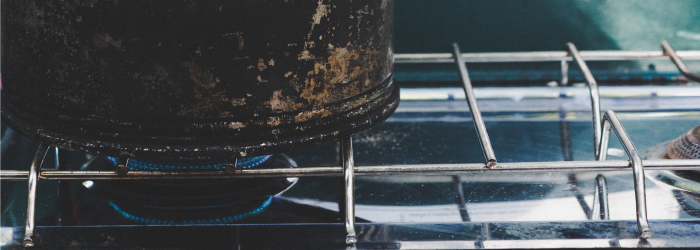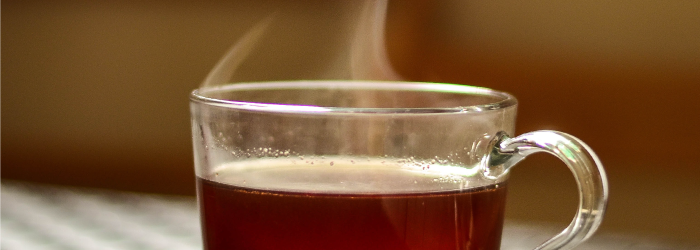What is the Best Way to Boil Water for Tea?

Released to public domain by Matthew McBrayer via Unsplash.
If high quality tea leaves are the star of a show in a good cup of tea, then the right water is the entire supporting cast. We’ve written before about the importance of water quality, but the flavor of this all-important ingredient can also be influenced by the method and vessel used to heat it. Today we’ll break down all the different ways to boil water, and how each one can affect your cup of tea.
Over a Fire
The most classic way to heat water uses a traditional heat source like a wood or gas fire under a metal pot or kettle. Though potentially imprecise, this method has been tried and tested through generations of tea drinkers, and many prefer it, whether for aesthetics or perceived flavor benefits.
Learn how to estimate water temperatures without a thermometer >>
Tetsubin
Truly dedicated tea devotees might invest in a tetsubin and charcoal stove to boil their water. This is the only method which unequivocally has a significant impact on flavor. Not to be confused with the modern cast iron teapots intended for brewing tea, tetsubin are traditional Japanese cast iron kettles with no interior coating, designed only for the purpose of boiling water.
Since they are directly exposed to the drinking water, they contribute iron to the final brew, which can enhance the flavor of some teas. They also retain heat for a long time, readily keeping water hot for a series of several infusions. However, they are also prone to rust and require careful maintenance, and are best heated slowly over a specialized charcoal stove.
Gas stove
Perhaps the most common method of heating water, gas stoves are versatile and easy to come by. Any stove-safe vessel, whether a sauce pot or whistling kettle, can hold water to be heated, and the direct heat of a gas flame heats water quickly and evenly. Whether in a home kitchen or over a propane-powered camp stove, a gas flame is a reliable way to heat water.
Released to public domain by Sarah Pflug via Burst.
Electric Heat
Modern methods of boiling water rely on electrical energy to power a heating element. While electric stovetops can take a while to reach their target temperature, induction-powered cooking surfaces will heat water even more quickly than gas in any metal pot or kettle with a flat base.
Electric kettle
One of the most convenient innovations for the modern tea drinker, many electric kettles are designed specifically for brewing tea. From long, narrow goose-neck styles that produce precise pours for tea and coffee to elaborate models that will hold water at an exact temperature, a good electric kettle can improve the brewing experience in many ways, especially for those who desire precision or have less attention to spare.
In addition, they are self contained, require no extra equipment, and can plug in to any outlet, making them perfect for the office or anywhere else where hot water might be hard to come by.
Find out how to brew loose leaf tea without any specialized equipment >>
Microwave
Boiling water in the microwave is highly controversial among tea drinkers. Some claim it negatively affects the flavor of the water, while others argue that the convenience is well worth any minor difference in taste. While microwaving water does not change any of the molecular compounds that produce flavor, the movement of air through water may have some impact on how the water tastes after boiling.
Released to public domain by Julia Sakelli via Pexels.
A microwave does heat water unevenly, which can also affect the extraction of flavor from the leaves when compared to water heated with other methods. Typically, the water near the top of the cup or mug will heat more quickly than at the base, leading to a cup that might feel misleadingly hot. Pouring the water into a separate cup after removing it from the microwave can help equalize the temperature, but it may still be too cool for teas that are best brewed at a full boil.
On the other hand, microwaved water also runs the risk of ‘superheating’, or reaching boiling temperatures without any release of gases within the cup. When the hot cup is disturbed or jostled, the hot water can erupt, posing a burn risk. Distilled or highly filtered water increases this risk, but placing an object with a relatively rough surface in the cup (like a wooden chopstick) will prevent this danger. This is why many sources suggest microwaving water with a tea bag already submerged. Unfortunately, this strategy is likely to result in a bitter cup.
Learn about the difference between loose leaf and bagged teas >>
Overall, microwaves make it more difficult to gauge the temperature of hot water, and increase the chance of under-brewing or over-brewing any given tea. Whether or not it changes the flavor of the water itself, it will likely change the results from a favorite tea that is normally brewed in a different way. While it isn’t our preferred method, it can be a passable substitute in a pinch.
Learn how to balance time and temperature for a better brew >>
How do you heat your water for tea? Let us know what you think in the comments below!
Sign up for our newsletter to get blog updates in your inbox!









Comments on this post (1)
Fantastic post! It was very interesting to know different ways to boil water for tea. Thanks for posting.
— Halmari Tea